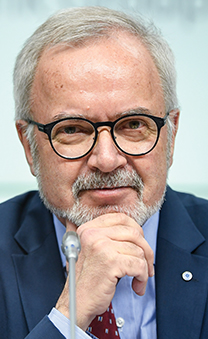By moving to a circular economy, the world can create less waste, design better products and adopt healthier habits, says European Investment Bank president Werner Hoyer, who explains why the EIB is joining a Europe-wide initiative to accelerate the use of this model.
Today, there are three fundamental drivers of the circular economy, which designs waste out of business models. First, we face pressing resource constraints. Moving towards a circular economy will foster sustainable growth on our planet, at a time when a fast-growing population consumes more products and depletes its finite resources. Moreover, we should be perfectly aware that the Paris Agreement to limit global warming to well below 2°C – or better to 1.5°C – above pre-industrial levels can only be achieved if we move to a circular economy model.
Second, technological developments are opening up new possibilities. New technologies, notably the Internet of Things and big data tools, enable the development and introduction of new business models, often based on sharing and leasing, as well as reuse and re-manufacturing. In addition, we can now track products and materials to extend their use and life, and design and manufacturing capabilities are evolving with advances in production, material science and manufacturing – including, for instance, 3D printing and artificial intelligence.
Third, socio-economic developments will see 60% of the world’s population living in cities by 2030. Increased urbanisation can support cost-effective collection and return systems for goods, materials and other resources, as well as asset-sharing schemes and systems for product reuse.
Transcending politics
These three drivers make it clear that that discussion should not be seen through any political or ideological lens. The current economic model of ‘take, make, dispose’ is unsustainable and costly. It is not about ideology or ‘Weltbild’, but about how we should invest in our future.
Initiatives on climate action have ensured that we are learning to reduce our carbon footprint, but we need to pay more attention to our material footprint: the quantity of materials we extract every day to meet our consumption needs. The European Commission has identified 27 raw materials as critical to our future because of the risk of a shortage and the high impact on the economy if we run out of them.
Nowhere are the severe ecological consequences of the linear economy clearer than when it comes to plastic waste. The World Economic Forum has estimated that 95% of plastic packaging material produced worldwide is lost to the economy after a short first use. A staggering 32% escapes collection systems, generating significant pollution in rivers and oceans and often finding its way back to us in the form of microscopic plastic particles in the fish we eat.
The European Investment Bank (EIB) is helping to tackle this threat with the Clean Oceans Initiative. Together with the French and German development banks, the Agence Française de Développement and the KfW, we are investing up to €2bn over five years to keep plastics out of the seas.
Rethinking economics
According to a report by business association Circle Economy, only 9% of the global economy is circular. This means that just 9% of the 92.8 billion tonnes of minerals, fossil fuels, metals and biomass that enter the economy are reused annually.
To move the world to a truly circular economy we need a new mindset. We need a new economic approach that cuts waste out of our system. All actors have to play a role: governments must put in place the right regulations and incentives, businesses must develop new business models and products, and consumers need to change their consumption habits.
One of the key challenges is the fact that new products or services for a circular economy meet stiff resistance in the linear economy, wherein raw materials are used to make a product, and after the product is consumed, it is thrown away. There is no circular use of a product. In this long-established, well-developed linear model, the economic assessment does not properly take into account the value of a circular product. For example, the full costs to society of our use of the environment and its resources are not reflected in a product’s price. An honest and transparent calculation of environmental benefits and societal value is important to create a level playing field between linear and circular products.
Time to get real
The financial community often overlooks the risks related to finite or unreliable sources of raw materials, and takes for granted it will always have access to the resources required to make a product. This is unrealistic – especially for long investment cycles – and must be taken into account in a credit risk assessment.
To advance the circular transition, the EIB joined forces with the largest development banks and institutions in Europe this year in an initiative that will provide €10bn over five years to accelerate our move to a sustainable and circular economy. This new programme will provide loans, investments and guarantees, and advisory support for projects that prevent and eliminate waste, save our natural resources and foster innovation by promoting circularity in all sectors of the economy.
Through this and many other initiatives, we aim to build a truly circular economy that will help preserve the planet for future generations. I invite you to join us in this endeavour.
Werner Hoyer is the president of the European Investment Bank.



